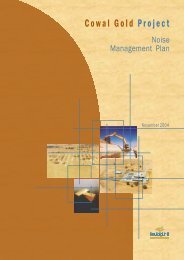January 2006 (PDF 2.9 MB) - Barrick Gold Corporation
January 2006 (PDF 2.9 MB) - Barrick Gold Corporation
January 2006 (PDF 2.9 MB) - Barrick Gold Corporation
Create successful ePaper yourself
Turn your PDF publications into a flip-book with our unique Google optimized e-Paper software.
0DWHULDO 6DIHW\ 'DWD 6KHHW<br />
R32 Contact with acids liberates very toxic gas.<br />
Classified as Dangerous Goods by the criteria of the Australian Dangerous Goods Code (ADG Code) for<br />
transport by road or rail.<br />
Class: 6.1 Toxic<br />
Poisons Schedule (Aust)/Toxic Substance (NZ): S7<br />
This material is a Scheduled Poison S7 and must be stored, maintained and used in accordance with the<br />
relevant regulations.<br />
4. FIRST AID MEASURES<br />
* Poison Information Centres in each State Capital City can provide additional assistance for scheduled poisons.<br />
* CONCURRENTLY WITH THE FOLLOWING FIRST AID PROCEDURES, TRANSFER PATIENT<br />
IMMEDIATELY TO HOSPITAL OR MEDICAL CENTRE, ACCOMPANIED BY AN ATTENDANT WITH THE<br />
CYANIDE EMERGENCY KIT.<br />
For all routes of exposure, remove patient from contaminated area and ensure rescuers avoid contamination.<br />
Give oxygen and if necessary, artificial respiration. If giving mouth-to-mouth resuscitation wash out patient’s<br />
mouth and lips - do not inhale patient’s expired air. Remove contaminated clothing and wash contaminated skin<br />
thoroughly. Get to ahospital or doctor quickly.<br />
Ingestion: * IF THE PATIENT IS CONSCIOUS:<br />
- Do not give anything by mouth.<br />
- Rest and reassure the patient who may become agitated.<br />
- If available, oxygen should be administered by a qualified person.<br />
* IF THE PATIENT IS UNCONSCIOUS AND BREATHING:<br />
- Do not give anything by mouth.<br />
- Lie the patient on their side, ensuring the airway is clear. If available, oxygen should be administered by<br />
aqualified person.<br />
* IF THE PATIENT IS NOT BREATHING:<br />
- Ensure airway is clear.<br />
- Commence expired air resuscitation using a pocket mask with a one-way valve. If available, oxygen should be<br />
administered by a qualified person. Take care to prevent contamination of the rescuer by removing all<br />
contaminated clothing and if giving mouth-to-mask recuscitation wash out patient’s mouth and lips - do not inhale<br />
patient’s air.<br />
- If cardiac arrest occurs (no pulse present), commence cardiopulmonary resuscitation (CPR).<br />
Eye contact: * Immediately irrigate with copious quantities of water for at least 15 minutes. Eyelids to be held<br />
open. Remove clothing if contaminated and wash skin. Treat as for ’INGESTION’.<br />
Skin contact: * If skin contact occurs, remove contaminated clothing and wash skin thoroughly. Can be<br />
absorbed through the skin with resultant toxic effects. Treat as for ’INGESTION’.<br />
Inhalation: * Remove victim from exposure - avoid becoming a casualty. Treat as for ’INGESTION’.<br />
EMERGENCY KIT FOR CYANIDE POISONING:<br />
At all places where there is a risk of cyanide poisoning, the following items should be kept in an accessible<br />
andconvenient location:<br />
. an oxygen resuscitator and a source of oxygen;<br />
. a clearly marked CYANIDE ANTIDOTE box containing:<br />
- an approved airway,<br />
- elasticised tournequet,<br />
Product name: Sodium Cyanide Solution - (30% w/w) Substance Key: 000033640201<br />
Issued: 27.01.2000 Version: 1.3 Page: 2 of 9

















